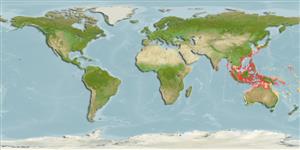Environment: milieu / climate zone / depth range / distribution range
Ecologie
marien rifbewoner; diepte 20 - 40 m (Ref. 559). Tropical
Western Pacific: southern Japan southward. Reported from the Indian Ocean (Ref. 45255). Randall & Pyle (2000, Ref. 48242) note that Pseudanthias manadensis has not been convincingly linked to any species recognized today.
Grootte / Gewicht / Leeftijd
Maturity: Lm ? range ? - ? cm
Max length : 9.5 cm SL mannelijk / geslacht onbekend; (Ref. 559)
Highly variable in color. Females have an orange to red spot on the back, centrally at the base of the spinous dorsal-fin, that elongates in larger individuals and males. In some males it shows as a yellow bar and some large individuals have extended tips on the caudal fin (Ref. 48635).
Inhabits rocky reefs. A deep water species, usually in depths over 40 m and appears to occur primarily on current-prone soft-bottom slopes (Ref. 48635).
Levenscyclus en paargedrag
Maturiteit | Voortplanting | Paaien | Eieren | Fecunditeit | Larven
Masuda, H., K. Amaoka, C. Araga, T. Uyeno and T. Yoshino, 1984. The fishes of the Japanese Archipelago. Vol. 1. Tokai University Press, Tokyo, Japan. 437 p. (text). (Ref. 559)
Status op de Rode Lijst van het IUCN (Ref. 130435)
Gevaar voor de mens
Harmless
Gebruik door de mens
Meer informatie
Lokale namenSynoniemenMetabolismePredatorenEcotoxicologieVoortplantingMaturiteitPaaienPaaiaggregatiesFecunditeitEierenOntwikkeling van de eieren
Leeftijd/GrootteGroeiLengte-gewichtLengte-lengteLengtefrequentiesMorfometrieMorfologieLarvenLarvale populatiedynamiekRekruteringAbundantieBRUVS
ReferentiesAquacultuurAquacultuurprofielKweeklijnenGeneticaElectrophoresesErfelijkheidZiektesVerwerkingNutrientsMassaconversie
Tools
Speciale rapporten
Download XML
Internetbronnen
Estimates based on models
Preferred temperature (Ref.
123201): 24.2 - 28.5, mean 28 °C (based on 93 cells).
Fylogenetische diversiteitsindex (Ref.
82804): PD
50 = 0.5000 [Uniqueness, from 0.5 = low to 2.0 = high].
Trofisch niveau (Ref.
69278): 3.4 ±0.4 se; based on size and trophs of closest relatives
Weerstandsvermogen (Ref.
120179): Hoog, minimale populatieverdubbelingstijd minder dan 15 maanden (Preliminary K or Fecundity.).
Fishing Vulnerability (Ref.
59153): Low vulnerability (10 of 100).
